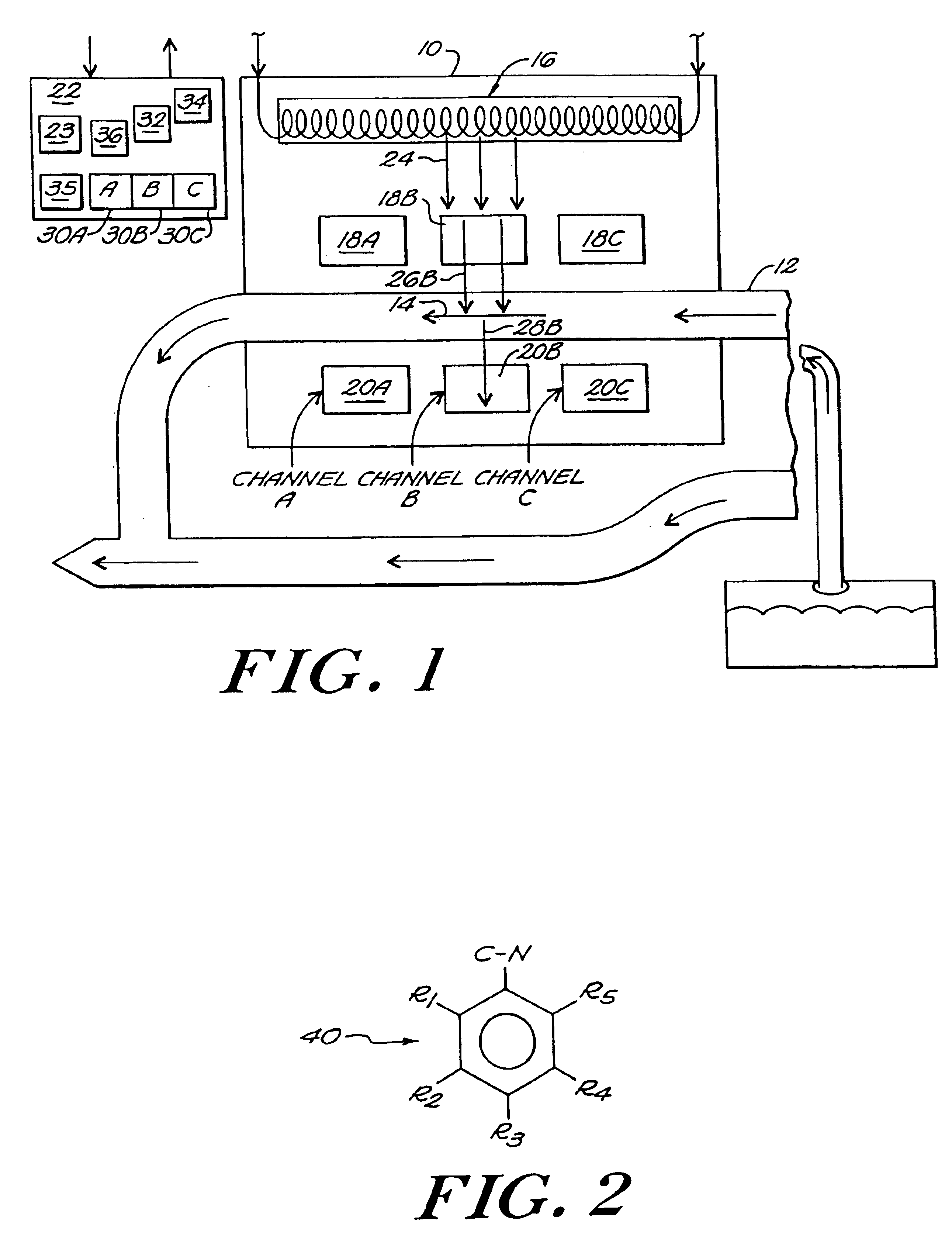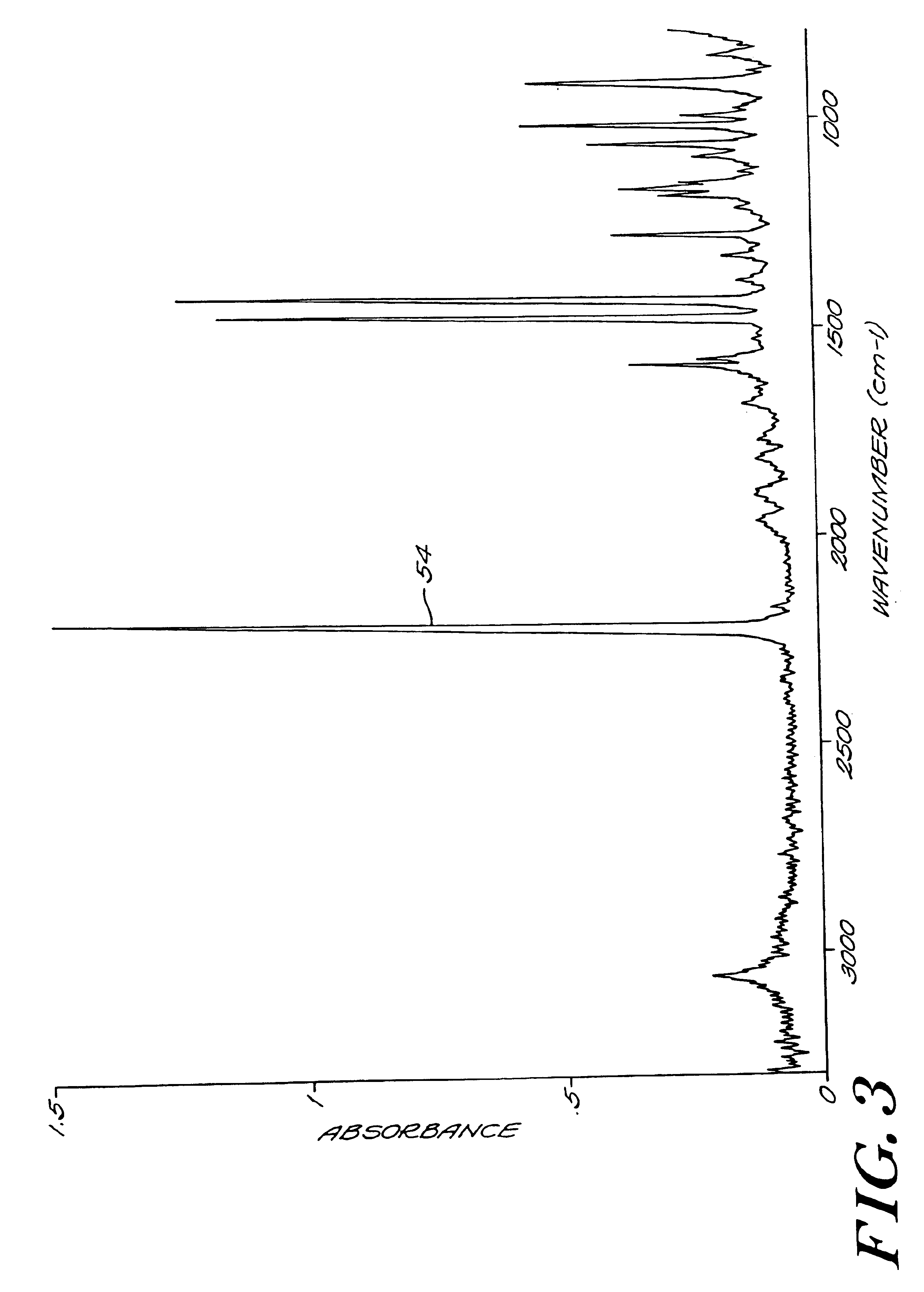Apparatus for marking and identifying liquids
a technology for identifying liquids and apparatuses, applied in the field of apparatus for identifying liquids, can solve the problems of unscrupulous persons' abuse of tax laws, easy to remove, silent markers do not provide any visual indication of identity, etc., and achieve the effect of convenient us
- Summary
- Abstract
- Description
- Claims
- Application Information
AI Technical Summary
Benefits of technology
Problems solved by technology
Method used
Image
Examples
example 1
[0046]A series 60, 62, 64, 66, and 68 of mid infrared spectrums of fuel containing different combinations of the two marker chemicals, natural abundance cyanobenzene and isotopically enriched cyanobenzene, are shown in FIGS. 5 and 6. Note that by combining the two marker chemicals in simple concentration ratios, in amounts of 0, 100 and 200 parts per million, this version of the invention defines five unique ways of marking the liquid, i.e. five marking patterns.
[0047]These ratios can be expressed by a quantization representation (CN:13CN) as 2:0, 0:2, 2:2, 2:1, 1:2. By providing the two above-referenced markers in concentrations corresponding to this quantization representation, FIVE distinct marking patterns are provided from the two marker chemicals. Adding additional multiples of the marker chemicals creates additional marking patterns, all from the same two chemicals.
[0048]This illustration provides two key features of the quantization marking pattern approach. First, the speci...
example 2
[0049]A further example is embodied in a family of marking patterns for gasoline made up by adding the two distinct chemicals, cyanobenzene and benzylisocyanate to fuel. Both are miscible in gasoline and other hydrocarbon fuels. Both chemicals have strong, sharp, distinguishable absorbance bands in the mid-infrared at wavenumbers 2230 and 2268 cm−1, respectively, but with absorbance strength at these frequencies in the approximate ratio of 1:4, also respectively. Further, these two bands are distinct from the background fuel absorbance of gasoline, which contains no chemical components with CN substituents in any of its blendants. The infrared spectra of fuel containing different combinations of the two marker agents (at about 1% concentration) are shown in FIGS. 7A, 7B, and 7C. In FIG. 7A cyanobenzene and benzyl isocyanate have a ratio of concentration of approximately 4:1, respectively. FIGS. 7B and 7C show ratios of concentration of approximately 2:1 and 8:1, respectively.
[0050]A...
example 3
[0057]The two dyes may constitute a family of markers in the following manner. FIG. 10 shows a series of mixtures of Morton 164 (Red-26) and FY131SC in varying parts-per-million concentration ratios from 5:1 to 1:1. All the mixtures appear red to an observer, since an observer cannot differentiate from which dye the color originates. But a simple readout device set to measure the absorbance at a wavelength specific to each marker dye, 520 nm for Red-26 and 550 nm for 131SC, can readily determine the amount of each dye present. A family of silent markers is quickly established on this basis, 5:1, 1:1, 1:5, for example. Each combination is a separate marking pattern and any deviation from the preset ratio and concentration indicates unauthorized or adulterated fuel.
[0058]Using a PetroSpec DT-100 portable dye analyzer, available from Boston Advanced Technologies, Inc., located in Marlborough Mass., set for the above wavelengths and calibrated for the two dyes mixed simultaneously in a ...
PUM
| Property | Measurement | Unit |
|---|---|---|
| wavelength | aaaaa | aaaaa |
| wavelength | aaaaa | aaaaa |
| wavenumber | aaaaa | aaaaa |
Abstract
Description
Claims
Application Information
 Login to View More
Login to View More - R&D
- Intellectual Property
- Life Sciences
- Materials
- Tech Scout
- Unparalleled Data Quality
- Higher Quality Content
- 60% Fewer Hallucinations
Browse by: Latest US Patents, China's latest patents, Technical Efficacy Thesaurus, Application Domain, Technology Topic, Popular Technical Reports.
© 2025 PatSnap. All rights reserved.Legal|Privacy policy|Modern Slavery Act Transparency Statement|Sitemap|About US| Contact US: help@patsnap.com



